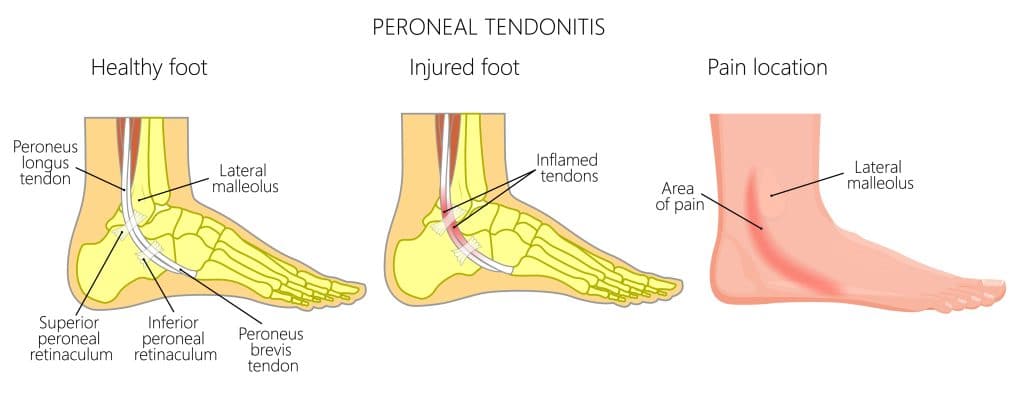Managing Peroneal Tendonitis: Effective Treatments and Preventative Measures
The human body has thousands of tendons, which are tough bands of tissue that connect muscles to bones. Although tendons are strong, if they become strained and inflamed, a painful condition called tendonitis can result.
Peroneal tendonitis is tendonitis in the tissues on the outside of your ankle and foot. Most people make a full recovery from it in around a month, but if you don’t treat the condition, you could need surgery.

What is peroneal tendonitis?
Peroneal tendonitis is inflammation of one or both tendons that run along the outside of your ankle and the side of your foot. It generally occurs due to overuse but can also happen because of an injury like an ankle sprain. Symptoms of peroneal tendonitis, like pain and swelling, are often treatable with self-care at home. Left untreated, however, the condition can get much worse and could require surgery.
Each of the two peroneal tendons helps stabilize your foot and ankle and help you balance. They attach the peroneus brevis muscle to the little toe, the peroneus longus muscle under the foot and to the arch on the other side, and both muscles to the bottom of the fibula.
Peroneal Tendonitis Symptoms
General symptoms that could indicate peroneal tendonitis include:

- Ankle pain along the tendon
- Pain on the outside of the foot and up the lower leg
- Swelling, redness, or warmth along the tendon
- Pain that’s worse early in the morning
- Pain that gets worse during activity or extended ankle use
- Difficulty running or walking
- Thickening of the tendons and possibly a mass or nodule that moves along with the tendons
Diagnosis
Diagnosing peroneal tendonitis can be challenging. Its symptoms are similar to other common foot and ankle issues like sprains, muscle tears, tendinosis, fractures, and arthritis.
To check for the condition, your orthopedic foot and ankle specialist will perform a physical exam. They will look for signs of swelling, tenderness, and decreased range of motion. They will also ask about your medical history, including recent illnesses or medications (steroid injections and some antibiotics can affect tendons). They’ll likely also take an X-ray, MRI, CT scan, or ultrasound to check for a foot fracture, osteoarthritis, cartilage damage, or other issues.
Causes
This condition typically develops over time due to friction from overuse or repetitive motions that cause tendons to rub against bone and swell. It may also happen suddenly after an injury, like a fall or sprain. It’s most common in people who play sports that require a lot of ankle movement.
Other groups more likely to develop the condition include those who:
- Are over 40 (since blood flow to tendons decreases with age, causing them to become thinner and easier to injure)
- Have had previous tendon or ankle injuries
- Have tight tendons
- Have have arches
- Wear inadequate or unsupportive footwear
- Have preexisting conditions like osteoarthritis, rheumatoid arthritis, diabetes, or gout
- Are overweight or obese
- Smoke
Non-Surgical Treatments for Peroneal Tendonitis
Generally speaking, self-care home treatments are a significant part of treating peroneal tendonitis, but you may also benefit from wearing a cast or boot as directed by your podiatrist.
The most commonly used treatments for the condition include:

- RICE therapy: RICE stands for rest, ice, compression, and elevation.
- Rest your foot and ankle by staying off them and avoiding strenuous activities as much as possible.
- Ice the area using a covered ice pack in 20- to 30-minute increments.
- Compress your foot and ankle by wrapping it with a compression bandage.
- Elevate your ankle (above your heart if possible) while sitting and sleeping.
- Medication: Take over-the-counter non-steroidal anti-inflammatory drugs like ibuprofen or aspirin. Also, ask your foot and ankle specialist about steroid injections to relieve pain and inflammation.
- Brace, boot, or cast: Wear an immobilization device to reduce the weight placed on your ankle so the tendons can heal.
- Physical therapy: Perform peroneal tendonitis exercises and stretches as recommended by a physical therapist to regain range of motion and strength.
Surgical Treatment
If the conservative treatments above do not lessen your symptoms, you may need surgery to remove the damaged tendon layers. This procedure is called a synovectomy. In some cases, your surgeon may be able to use a minimally invasive arthroscopic procedure that requires smaller incisions for a quicker recovery.
If left untreated, peroneal tendonitis can worsen, causing the tendon to partially or fully tear (rupture). Failure to treat the condition can also damage or weaken tendons, leading to subluxation, which is when the tendons become dislocated. Ruptured or subluxated tendons can cause weakness or chronic ankle instability, severe pain on the outside of the ankle or foot, or a sharp, snapping feeling in the tendons.
Prevention
Preventing orthopedic issues is always the best approach. While certain injuries are unexpected and happen even when you’ve done everything “right,” some of the following best practices can help overuse issues:
- Maintain a healthy weight
- Work up to increased levels of exercise over time
- Pay attention to early signs of overuse or injury
- Rest between bouts of exercise or sporting events
- Stretch or perform strengthening activities as directed
- Wear proper protective gear like an ankle brace or supportive shoes
- Talk to your foot and ankle specialist about orthopedic insoles
- Don’t smoke
Other Types of Tendonitis
Tendonitis is a relatively common condition. For more information on other types of tendonitis, see these posts:
If you have foot or ankle pain and would like to speak with a specialist about what could be causing it and how to treat it, contact us or comment below.
Leave a Reply